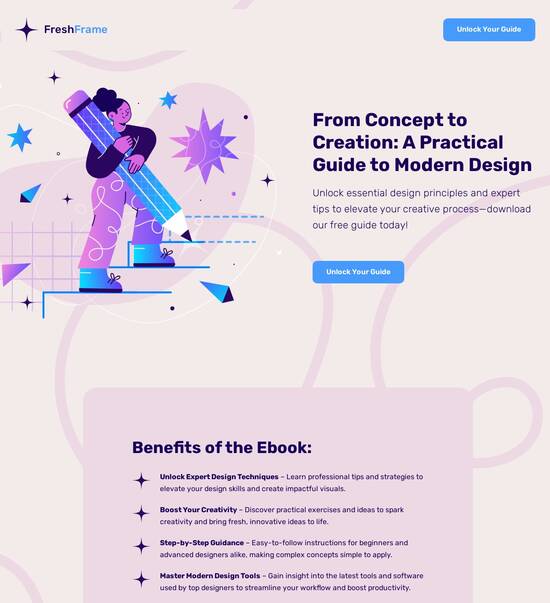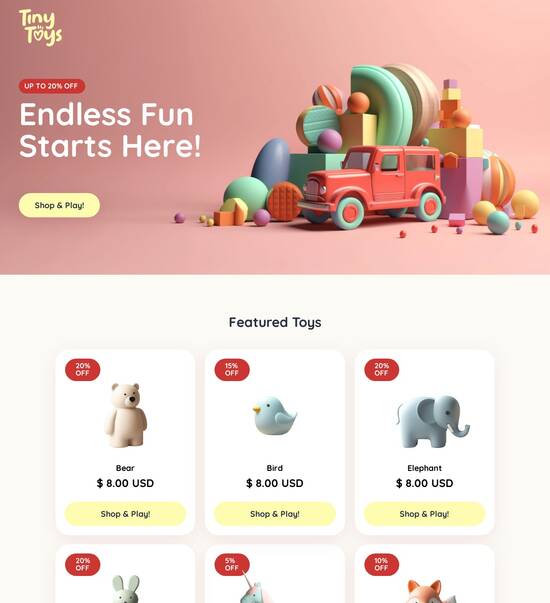
Microsite Template Optimized for CentOS
Explore Similar TemplatesAbout template
Create customized and effective landing pages quickly with our Microsite template optimized for CentOS.
Recommended templates

Easy to build without coding
With the intuitive drag-and-drop builder, anyone on your team can create high-converting pages without any knowledge of code or design. Make enhancements to your landing page with custom widgets using Javascript, HTML/CSS, or third-party scripts.

Multiple layouts for any industry and goal
Select from 500+ landing page layouts built to boost conversions across industry-specific scenarios. Customize them by adjusting fonts, adding images, and generating on-brand content with the AI assistant. Quickly scale with Instablocks® and Global Blocks that you can save, reuse, and update globally.

Loads fast and looks polished on any device
Every template is responsive, which means they present professionally on any device and load blazingly fast with our Thor Render Engine. You can also power them up with Google AMP technology to deliver an unparalleled mobile experience and drive higher conversions.

Robust analytics & experimentation
Get real-time updates and reporting across all your devices, showing the number of visitors, conversions, cost-per-visitor, and cost-per-lead. Launch AI-powered experiments, run A/B tests, and use heatmaps to analyze user behavior, then optimize your landing page to maximize conversions.







Easy to build without coding
With the intuitive drag-and-drop builder, anyone on your team can create high-converting pages without any knowledge of code or design. Make enhancements to your landing page with custom widgets using Javascript, HTML/CSS, or third-party scripts.
Multiple layouts for any industry and goal
Select from 500+ landing page layouts built to boost conversions across industry-specific scenarios. Customize them by adjusting fonts, adding images, and generating on-brand content with the AI assistant. Quickly scale with Instablocks® and Global Blocks that you can save, reuse, and update globally.
Loads fast and looks polished on any device
Every template is responsive, which means they present professionally on any device and load blazingly fast with our Thor Render Engine.
Robust analytics & experimentation
Get real-time updates and reporting across all your devices, showing the number of visitors, conversions, cost-per-visitor, and cost-per-lead. Launch AI-powered experiments, run A/B tests, and use heatmaps to analyze user behavior, then optimize your landing page to maximize conversions.
All the features you need to build lead-generating landing pages
Explore more featuresLearn how to build top-performing landing pages for any goal
FAQs
Leading the way in building high-performing landing pages





Your comprehensive guide to mastering Instapage's powerful landing page and CRO platform
Instapage serves as an indispensable tool for marketers looking to create high-converting landing pages that maximize ROI. Its user-friendly interface and robust feature set enable marketers from various fields, including tech, education, and financial services, to enhance their lead generation strategies effectively.
Understanding landing pages and their importance in digital marketing
Landing pages are standalone web pages designed specifically for a marketing or advertising campaign. They serve a single purpose: to convert visitors into leads or customers. This section explores how Instapage can help you create landing pages that are tailored to your audience, boosting engagement and conversion rates.
- Focused messaging: Instapage allows you to craft targeted messages that speak directly to your audience's pain points.
- Streamlined design: Built with 100+ templates, customization is intuitive, ensuring your pages look professional and appealing.
- Effective call-to-action: Clear CTA buttons can be embedded to guide visitors towards taking action, increasing conversion rates.
Step 1: Select the right template for your campaign
Choosing an appropriate template is crucial for the success of your landing page. Instapage offers a wide selection of conversion-focused designs that cater to various industries and purposes. Start by identifying your campaign goals and select a template that aligns with them.
Step 2: Customize your landing page
Once you've chosen a template, it's time to make it your own. Use Instapage's drag-and-drop builder to customize elements like text, images, and forms. Focus on the following aspects:
- Dynamic text replacement: Tailor your content to resonate with specific audience segments, making it more personal.
- Integrating lead generation elements: Enhance lead capture using forms, buttons, and pop-ups that encourage visitor interaction.
- Visual consistency: Ensure your landing page reflects your brand through color schemes, logos, and typography.
Step 3: Optimize and analyze performance
Once your landing page is live, ongoing optimization is key to achieving better conversion rates. Utilize Instapage's built-in analytics to assess performance metrics.
- A/B testing: Experiment with different versions of your landing page to discover which elements drive the most conversions.
- Heatmaps: Gain insights into user behavior on your pages to identify areas for improvement.
- Feedback loop: Use real-time data to iterate and enhance your landing page continuously.
By following these steps, marketers can effectively utilize Instapage to create and manage high-converting landing pages that align with their digital marketing goals.
Ready to unlock the potential of your digital marketing campaigns? Start creating high-performance landing pages with Instapage today!
Unveiling the power of microsite templates optimized for CentOS
Understanding the framework: CentOS for web development
CentOS is a community-supported, free software operating system based on Red Hat Enterprise Linux (RHEL). Its stability, security, and long-term support make it an ideal choice for web development projects, particularly when hosting microsites. As a widely embraced server OS, CentOS provides an environment that enhances the performance of dynamic websites while ensuring reliability.
Its attributes cater well to businesses that demand a robust infrastructure. CentOS allows web developers to set up environments with efficiency and minimal hassle. For those building microsite templates, the stability afforded by CentOS ensures that these small, focused sites operate without consistent downtime or performance lags.
Reliability: CentOS is known for its reliable performance, making it suitable for long-term projects.
Security: Regular updates and a strong security model help protect microsites from vulnerabilities.
Cost-effective: Being free to use makes CentOS a budget-friendly choice for businesses.
Essential technologies built upon CentOS
When creating microsites on CentOS, leveraging essential technologies like Apache or Nginx as web servers can significantly impact the site's performance. These servers are designed to handle multiple requests efficiently, providing fast response times that can enhance user experience. For dynamic microsites requiring database interactions, integrating technologies such as PHP and MySQL is indispensable.
Apache offers flexibility and extensive features, while Nginx is known for its strong performance under high load. The combination of these technologies allows developers to create well-optimized microsites tailored to business objectives and user needs.
Navigating the microsite landscape
Microsites serve specific marketing objectives, targeted audiences, or particular campaigns distinct from traditional websites. Typically smaller in scale, they often focus on a single product, service, or event. In doing so, microsites allow brands to create a highly relevant user experience that isn’t often achievable on larger, fuller-featured websites.
One notable advantage of microsites is their responsiveness to market trends or specific business goals. They are strategic tools for marketing campaigns, capable of capturing leads and enhancing brand messaging by providing tailored content. Effectively, microsites allow organizations to convey specific narratives that resonate deeply with prospective customers.
Focused content: Concentrating on a specific topic increases relevance.
Hyper-targeted messaging: Communication tailored to specific demographics boosts engagement.
User-centric design: Tailored interfaces enhance navigation and conversion rates.
Feature-rich microsite templates: A deep dive
Utilizing pre-designed microsite templates specifically optimized for CentOS can streamline the creation process. These templates come equipped with best practices in design and development, which can significantly save time and resources. The primary advantage lies in avoiding the complexities often associated with custom builds while still allowing sufficient flexibility to address specific branding requirements.
When designing templates for CentOS, ensuring compatibility with the underlying technologies is crucial. It's important to consider how certain features will interact with the web server and scripting languages utilized. The best templates exhibit clean, semantic HTML structures, ensuring high search engine rankings while being easily customizable to reflect unique brand identities.
Cost efficiency: Reduces the need for extensive development time.
Time-saving: Enables rapid deployment of microsites.
Customization flexibility: Offers options to adapt while using a structured approach.
Optimizing content for maximum engagement
Creating compelling content for microsites involves crafting messages that resonate with target audiences while providing value. Balancing visuals and textual content is key to maintaining user interest and driving conversions. High-quality images, concise messaging, and strong calls to action can significantly increase engagement levels.
Additionally, utilizing A/B testing strategies facilitates an understanding of what resonates best with users, allowing for informed content modifications. Analyzing results from these tests provides insights into user preferences, informing future content creation, and refining user experience.
Visual appeal: Attractive images and video integrate well to engage users.
Concise information: Delivering key points without overwhelming the reader enhances focus.
Strategic CTA placement: Calls to action must be clearly visible and compelling.
SEO best practices for microsite content
To maximize the visibility of your microsite, implementing effective SEO strategies is essential. One of the core elements is conducting comprehensive keyword research tailored to audience intentions. This aids in targeting the right phrases that audiences might search for, ensuring content aligns with user needs.
Moreover, leveraging schema markup contributes positively to search engine indexing, enhancing your site's visibility in search results. Implementing structured data gives search engines additional context about the content on your microsite, translating to possibly better rankings and increased click-through rates.
Engaging communities and building customer connections
Engaging communities is integral to amplifying your microsite's reach and impact. Identifying key platforms where target audiences congregate allows for effective content distribution. By tailoring messages for these platforms, businesses can drive increased traffic to their microsites and build relationships with potential customers.
Additionally, encouraging social sharing can serve as a valuable tactic to increase engagement. Integrating social sharing buttons and prompting users to share valuable content can exponentially increase visibility, opening the door for organic traffic growth.
Identify platforms: Focus on areas where target markets engage actively.
Create shareable content: Valuable, informative content encourages sharing.
Utilize visual storytelling: Engaging visuals capture attention and promote interaction.
Facilitating Q&A sections for enhanced interaction
Implementing a well-designed FAQ section can significantly improve user interaction on your microsite. Anticipating user questions and proactively offering solutions fosters trust and enhances the overall user experience. Clear, concise answers encourage users to explore the microsite further.
To maintain a rich interaction environment, moderating community questions is vital to ensure relevant and respectful dialogue. Regularly updating content based on user inquiries can also provide insights into prevalent audience concerns, informing ongoing content strategies.
Innovative ways to capture and analyze visitor data
Understanding user behavior is crucial for ongoing optimization of microsites. Reliable analytics tools such as Google Analytics and heatmaps allow businesses to track essential metrics. Monitoring bounce rates, average session time, and user paths enable data-driven decisions that can significantly impact future strategies.
In addition, streamlining data collection through integrated forms and pop-ups ensures valuable lead generation. Tailoring experiences based on gathered insights fosters personalized interactions and optimizes user experience, further solidifying customer relationships.
Key metrics: Focusing on bounce rate and session duration guides optimization.
Use heatmaps: A visual representation of user engagement aids in refining layouts.
Segment data effectively: Tailor content and offerings based on analytics insights.
Implementing previews and feedback mechanisms
Creating engaging previews plays a key role in gathering insights during the design iteration phase. By utilizing user feedback platforms, developers can create mock-ups that engage stakeholders early. This aids in identifying potential areas for improvement before the final rollout.
Following deployment, encouraging continuous feedback allows for ongoing enhancements. Engaging users post-launch can reveal insightful feedback that informs future changes, fostering a culture of innovation and responsiveness.
Utilize mock-up tools: Creating engaging previews captures user attention.
Encourage participant feedback: Involving users in early stages yields valuable insights.
Regular updates: Continually refining the microsite ensures it meets evolving user needs.
Collaborating across teams and collectives
To maximize the potential of microsites, building a cross-functional team is essential. Establishing roles and responsibilities clarifies the workflow and leverages the collective strengths of team members. This ensures that design, content, and technical aspects are cohesively managed for optimal results.
Fostering a culture of open collaboration is equally important in maximizing innovation. Regular brainstorming sessions encourage diverse inputs and ideas that lead to holistic solutions tailored to user expectations.
Define roles clearly: Ensure everyone knows their responsibilities within the project.
Encourage collaboration: Open dialogue between teams enhances project momentum.
Solicit diverse ideas: Utilizing various perspectives can lead to innovative solutions.
Scaling and evolving microsites for business growth
As businesses grow, so too should their microsites. Planning for future expansion should be an integral consideration during the development phase. Creating a strategy to scale microsites involves identifying new local markets or themes that could benefit from unique, targeted microsite experiences.
Examining successful case studies of companies that have effectively implemented microsites can provide valuable lessons. Each implementation offers insights into best practices and highlights potential pitfalls to avoid, ultimately informing stronger future strategies.
Growth strategy: Planning for scalable solutions enables seamless integrations.
Explore new avenues: Identify opportunities for targeted microsites.
Learn from case studies: Gather insights from successful implementations to inform future efforts.
Troubleshooting common issues when working with CentOS
When implementing microsite templates on CentOS, it’s essential to identify and troubleshoot potential roadblocks quickly. Server-related issues can arise, such as configuration errors or incompatibility with installed modules. Having a checklist for common issues can facilitate quicker resolution and minimize downtime.
Additionally, availing oneself of available resources for continuous learning, such as online communities and documentation, can provide ongoing support. Engaging with user forums allows developers to share experiences and solutions, fostering an environment of shared knowledge.
Maintain a checklist: Identify common issues to streamline troubleshooting.
Engage online communities: Use forums to find solutions others have implemented successfully.
Refer to documentation: Comprehensive documentation provides guidance for effective troubleshooting.
Ready to skyrocket conversions?
Supercharge your ad campaigns with high-performing landing pages
Get started














